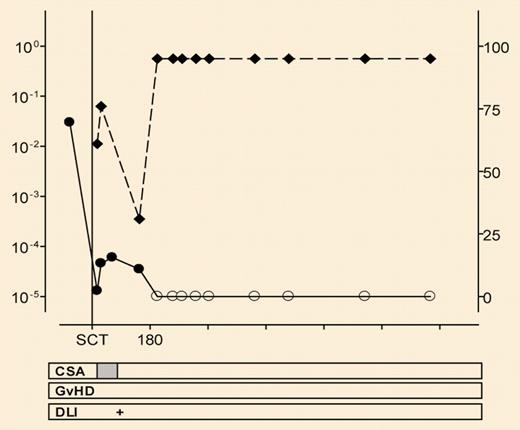Comment on Ritgen et al, page 2600
Chronic lymphocytic leukemia with unmutated IgVH genes can be suppressed by the immunologic effects of stem cell allograft.
Chronic lymphocytic leukemia (CLL) is generally considered treatable but ultimately incurable even by high-dose chemotherapy. Because most patients are elderly, conventional stem cell allografting is too hazardous for all but a few. In this issue, Ritgen and colleagues raise the hope that the immunologic effect of allograft with reduced-intensity conditioning may sufficiently suppress the disease to make cure a possibility.
CLL comes in 2 forms: the first, with mutated immunoglobulin variable region (IgVH) genes, is usually benign with an average survival of 25 years; the second, with unmutated IgVH genes, is usually lethal with a median survival of 8 years.1,2 Abnormalities of the p53 pathway (chromosomal deletions at 17p13 or 11q23) make things worse.3 Patients with 17p13 deletions survive for only 3 years on average. A previous study by the German group4 demonstrated that high-dose chemo-radiotherapy followed by autologous stem cell rescue produced long-lasting, complete remissions in CLL with mutated IgVH genes. Furthermore, elimination of minimal residual disease (MRD), detectable by a sensitive IgH real-time polymerase chain reaction (PCR) assay, was achieved in all and maintained in most patients. On the other hand, in patients with unmutated IgVH genes treated in this way, complete remissions lasted on average only 3 years and reappearance of MRD was inevitable by 4 years.
The new study of 9 patients receiving a stem cell allograft after reduced-intensity conditioning demonstrates that control of MRD in patients with unmutated IgVH genes can be achieved by the immunologic effects of the grafted stem cells. In 5 patients, the disappearance of MRD appeared to be a consequence of the development of graft-versus-host disease. Two of the remaining patients became MRD negative after donor lymphocyte infusion (DLI). One patient remained in remission without eliminating MRD despite DLI, and one patient died from progressive disease despite DLI. This last patient was the only one with a chromosome deletion at 17p13, implicating p53 malfunction.FIG1
MRD kinetics after autologous stem cell transplantation (SCT) and nonmyeloablative allogeneic SCT. See the complete figure in the article beginning on page 2600.
MRD kinetics after autologous stem cell transplantation (SCT) and nonmyeloablative allogeneic SCT. See the complete figure in the article beginning on page 2600.
Stem cell allograft with reduced-intensity conditioning can be performed well into the age range when CLL becomes common. This paper encourages us to enter more patients into clinical trials to evaluate this treatment. However, the prospect for patients with p53 abnormalities remains dismal, and this problem remains the focus for intensive research. ▪


